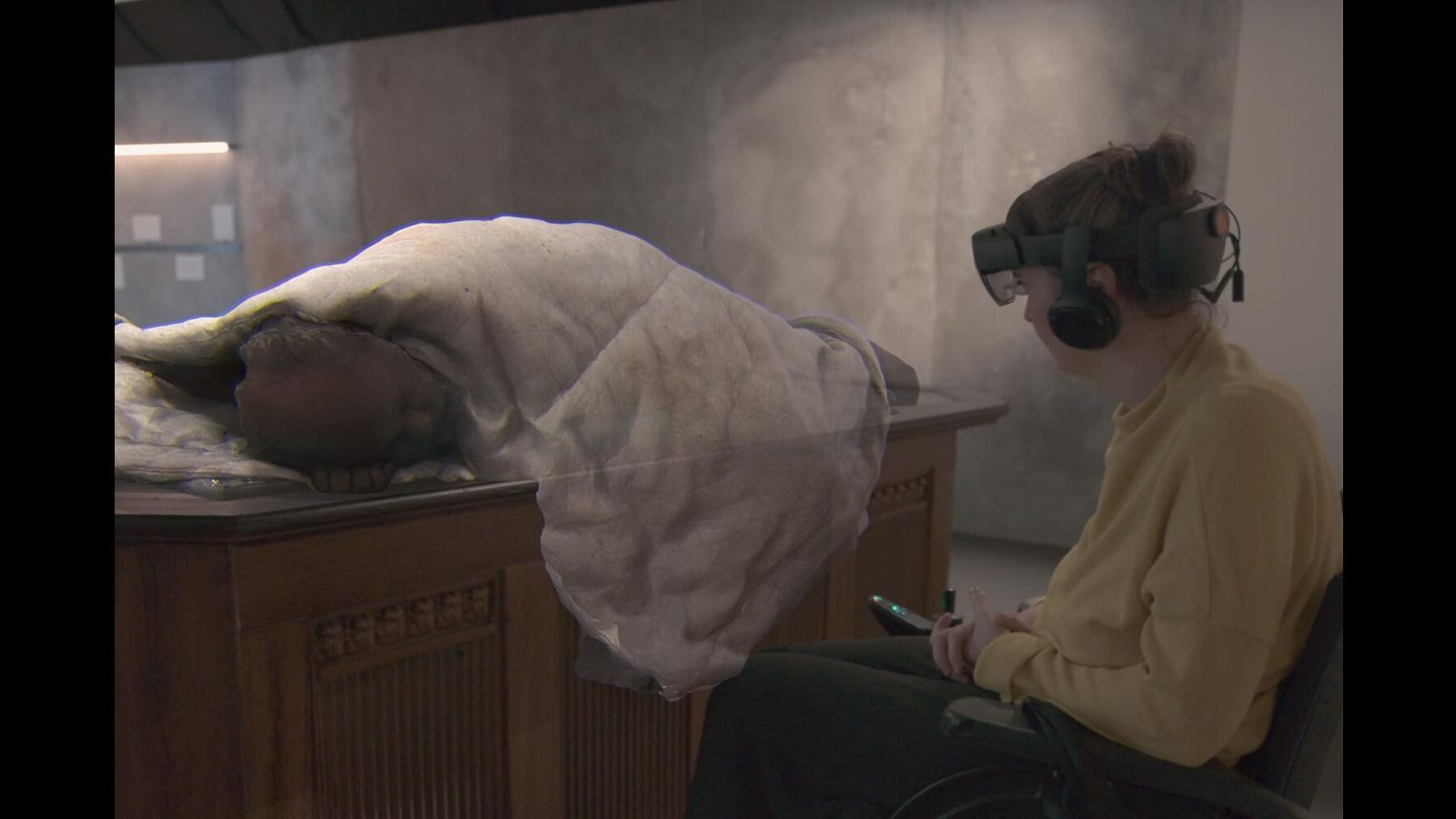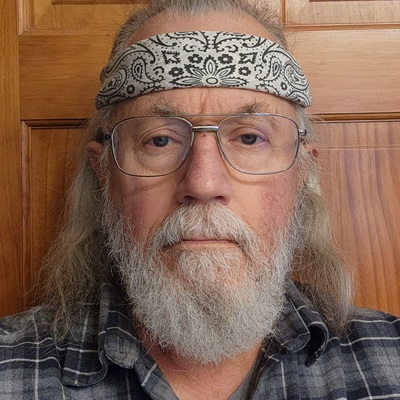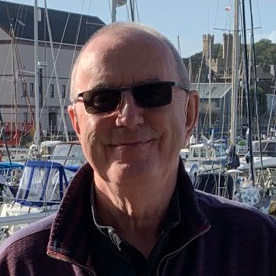Museum of Austerity, recently displayed at the HOME arts centre in Manchester, UK, brings to life the terrible plight of 10 of the disabled victims of a brutal and inhumane benefits system who were failed and left to die.
The exhibition, co-produced by the English Touring Theatre and Trial and Error Studio, combines the skills of theatre/XR director Sacha Wares and the in-depth knowledge of John Pring, editor of the Disability News Service (DNS).
The installation utilises holographic/augmented technology creating life like images and recorded interviews with family members drawing together the terrible personal and social impact of over a decade of brutal austerity.
The viewer is provided with a headset and walks into an empty space. One is then struck by the glowing images, played by actors, of 10 of the victims coming to life within touching distance. Recorded testimony is provided from a real family member fed through the wearer’s headset.
In the background is heard the voices of politicians in the House of Commons pontificating on how the benefits system is far too generous and facing fraudulent claims.
Standing in front of each one of these images, their stories are described in harrowing step by step detail, showing how they were failed by an inhumane and punitive benefit system, administered by the Department of Work and Pensions (DWP)
Listening to what happened to each of the victims, one is left wondering how could this have happened in one of the richest countries in the world? What if anything was in place to protect these people, who were clearly vulnerable, and struggling to engage with a benefits system, but were left to die?
David Clapson’s sister Gill Thompson speaks about the period leading to his tragic, preventable death. David had diabetes and died in July 2013 due to an acute lack of insulin. His only paltry form of income, Job Seekers Allowance, was sanctioned just three weeks earlier. He was unable to afford to pay for electricity to be able to keep the fridge running where he had to store his insulin.
An autopsy revealed that his stomach was empty. The only food found in his flat were six tea bags, an out-of-date tin of soup and a can of sardines. He had just £3.44 left in his bank account. The DWP admitted that they were aware that David was insulin dependent. Gill said, “I feel that the sanction resulting in my brother being left destitute and having no money to chill his insulin or to buy food, ultimately led to his untimely death”.
Imogen Day, sister of Phillipa Day, said she had been claiming Personal Independence Payment (PIP) until it was stopped by the DWP. Phillipa was a vulnerable 27-year-old who was found at home after having taken an overdose in August 2019. She died two months later in hospital. An inquest into her death held in January 2021 found that there had been 28 instances where systematic errors by both the DWP and Capita—a private sector firm—had led to failures in the handling of her benefits claim. Capita were carrying out assessments for PIP.
Following her PIP being stopped, Phillipa’s weekly income fell from £228 to £60 a week. At the inquest, a telephone recording was played of Philippa pleading with a benefits official for help. She can be heard crying telling the official, “I’ve been waiting for six months now. I’m literally starving, I can’t survive for much longer”. She added, “[I’m in] £5,000 debt. Nothing to eat. I’ve lost all my [benefit] premiums… I cannot survive… without any money. I need something to live for”.
The coroner ruled that although he was unable to conclude she intended to take her own life, the failures were a stressor in her decision to take the overdose.
The cases examined at the Museum of Austerity reveal a benefit system in chaos, with claimants victimised and denied access to social security. At the same time DWP staff are struggling due to unrealistic workloads, with many ending up having to leave.
Disability News Service revealed that a third of work coaches on a single floor of a job centre in Oxford have experienced a mental health crisis in less than a year. Oral evidence showed that working conditions were so stressful that in a team of 23 work coaches, 15 had quit the job within a 12-month period.
The resignations followed the introduction of the DWP’s “Way to Work” scheme launched in January 2022, set up to significantly increase the numbers of Universal Credit claimants returning to work who had lost their jobs during the pandemic. It set a target of forcing 500,000 people into employment by cutting job seekers’ benefits after four weeks unless they applied for work outside their normal occupation.
Work coaches at the Oxford job centre told DNS that the new scheme meant they had to deal with 27 appointments a day, when they had previously had to see between 17 and 19 a day.
The attacks on disabled people claiming benefits will intensify with Chancellor Jeremy Hunt’s Autumn Statement announcement that those on welfare payments who do not find a job within 18 months will be forced to undertake work experience. After six months of sanctions if they have still not got a job, they will lose their benefits altogether and even the right to free National Health Service prescriptions and legal aid. These measures will impact hundreds of thousands from 2025, with Hunt boasting they will save the government £4 billion.
“Premature mortality attributable to socioeconomic inequality in England between 2003 and 2018: an observational study,” by the University College London, published in 2019 in The Lancet Public Health, found that between 2003 and 2018, 877,000 people died as the result of rocketing social inequality.
An important part of the exhibition is a meticulous timeline used by the curators, titled, “Deaths by Welfare”, chronicling the attacks carried out on the welfare state by Tory and Labour governments from its initial conception in the 1942 wartime Beveridge Report to the present day.
Under conditions in which both the Sunak government and Labour opposition are committed to continuing austerity whoever wins the general election, this hard-hitting exhibition struggled to find venues willing to host it.
Wares has directing productions for more than 20 years, in her words to “tell stories that reflect the concerns of our times”. These include a 2004 production, Guantanamo, dealing with the “rendering” (kidnapping) and savage treatment of detainees in that hell on earth. She said, “As a theatre director I’ve been fortunate because usually when I want to make something there’s a home for it and I can get it made”. Now there is a backlash. “It’s been really striking with this piece of work that’s not been the case. And you wonder: is that a change in the confidence of the sector to be political?”
Museum of Austerity deserves the widest audience. The powerful exhibition is innovative and stands as an indictment not just of a slashed to shreds, punitive system that has systematically persecuted benefit claimants—even to their deaths—but of the entire political set-up which exists only to benefit a super-rich minority and the profit lust of the capitalist class.
Museum of Austerity was shown at HOME from November 8-11 and is showing at a number of venues during spring 2024 to be announced.
I went to a food bank today for the first time in my life. I didn’t expect much, it’s charity after-all.
They gave me 2 big carrier bags - I couldn’t stop thanking them and carted them home.
When I opened them at home I noticed chocolate. I cried…cos I hadn’t even thought of buying myself chocolate in months cos it seemed so frivolous. But they put some chocolate in. It was so kind. 🥲
There’s so much suffering out there. It can happen to anyone. I founded and ran two companies in my 20s. High flying career and was making £50 at my last job in tech.
All fell apart 2 years ago. Been struggling to piece my life together ever since.
Please be kind to each other.
We regularly contribute to foodbanks in the UK and we always include treats and toiletries ❤️
Really hope you get your life back on track🫂
As we say at the food bank here:
“Hunger can affect anyone and anyone can affect hunger”.
Donate, volunteer and support your local food bank.
@Fudoshin @DessertStorms I’m involved with a local food bank, and when we have little extras like that or flowers to give out, it really makes our day too!
@Fudoshin @DessertStorms the thing that made me cry, when I needed a food bank, was they asked if I had pets and included food for my cats.
There is an awful lot of good in this world.
@Fudoshin @DessertStorms May brighter days be timely. So many of us have needed that core generosity at one time or another, we were gifted shoes and wardrobes and a pantry from the Salvation Army after Hurricane Irene in Vermont USA, I kept walking around trying not to show I was crying by hiding in the clothes racks. Best of luck.
@Fudoshin
When I drove a “food rescue van” for a local food pantry collecting birthday cakes from the grocery stores’ bakeries was the height of my day. People who shopped at the pantry were registered; when they checked in volunteers checked for kids with birthdays coming soon & notified the volunteers assisting shoppers to give them a cake.I sometimes hung around to watch the faces as folks left with them. There was almost at least one every day. I sometimes got 4 or 5 cakes on a trip.
I had to go to a food bank once. Because I have dietary issues they gave me a Tesco voucher, everyone was so kind. It was a really humbling experience but not an awful one.
I’m doing much better these days and you will be soon too.
@Fudoshin @DessertStorms@kbin.social ❤️
@Fudoshin @DessertStorms
I volunteer with a London charity that provides food to Foodbanks. We get food from farmers, high end restaurants, supermarkets etc. It very good quality and we are mindful when we pick orders from foodbanks, schools, play centres and hubs that we are picking for individuals, children and families . Of course we add in sweet treats xxx@Fudoshin @DessertStorms Mutual aid FTW! I am so glad you found support in your community.
@Fudoshin @DessertStorms@kbin.social
And I’m reminded, as a psychologist and a Buddhist,* that being kind and humane to others benefits us, too. It really does.
____
(*In my over-educated view, being a psychologist and a Buddhist are the same thing in the end.)@Fudoshin
Oh mate. :sends hug:@Fudoshin @DessertStorms
I understand the way you feel about the chocolate. I’ve been using commodities program all year; I too once had money, was ‘middle class’ & how delighted I was they included a cake in Dec. commodities. This month it’s mostly potatoes and nuts. I did get 2 dz eggs a and 8 grapefruits too. And a sack of 60 lbs of potatoes, 11 lbs. of walnuts, 6 lbs of almonds & 4 lbs of raisins.if I didn’t have dried beans left over from before I’d be living on trail mix .deleted by creator
I’m sorry to hear you’ve been having a hard time but glad you were able to get some support and compassion locally.
We shouldn’t need food banks, but their existence is proof that communities will look out for each other with or without central government telling them to or even funding them, and while they represent a failure of our current system, I also see them as representing hope for what a future could look like without outside of a for-profit existence.
@Fudoshin @DessertStorms Support your local food bank! It doesn’t take much money to provide a big bag of food for folks.
Farmers, please grow a little more produce and give that excess away if you can.
@Fudoshin @DessertStorms Bad things can happen to everybody indeed. 😔
But even (or especially) when you feel like it won’t happen to you, you should be kind to others and help them. Helping each other doesn’t have to be reciprocating.
@Fudoshin every few months we are usually back at ours. We try to go as little as possible. Sweetest people, when I was younger and a dependent I volunteered there. It sucks but I am glad they have the same mission and have stuck to it so well all these years.
😢 hang in there.
@Fudoshin @DessertStorms My roommate and I will be visiting a food bank for the first time in our lives, this week, too. I was fired right before Xmas, and my UI hasn’t kicked in yet, so I suggested we go and try to get some frozen veggies and some chicken or something. I’m celiac so I doubt they’ll have much in the way of dedicated gluten-free, but if they have something we’ll be grateful.
@Fudoshin @DessertStorms @Tooden this reflects my experience of needing a food bank for a while last year. They even did their best to accommodate dietary needs.
deleted by creator
“Austerity” is a term rich people invented to explain what you will sacrifice for them.
John Pring of Disability News Service on Museum of Austerity exhibition
“I hear from disabled people about the slow, grinding, torturous impact that the disability benefits system has on them, often over months or even years.”
John Pring is a journalist and editor of the Disability News Service (DNS). Pring has reported on disability issues in the UK for nearly 25 years.
The website explains that Pring “launched DNS in April 2009 to address the absence of in-depth reporting in both the specialist and mainstream media on issues that affect the lives of disabled people. The news service focuses on issues such as discrimination equality, independent living, benefits, poverty, activism and campaigning and human rights, but also covers employment, transport, education, housing, crime, and arts, culture and sport.”
Pring brings his expertise to bear as Specialist Advisor & Co-Editor in a ground-breaking installation, Museum of Austerity (MoA), which recently opened at the HOME arts complex in Manchester and will tour at other venues in the UK next spring.
WSWS reporter Dennis Moore interviewed Pring about the Museum of Austerity, his involvement and the issues it raises.
Dennis Moore (DM):
What motivated you to want to bring these individual stories out to the public in this format?John Pring (JP)
Sacha Wares first approached me to work on this project more than three years ago. She told me about a new project that would use state-of-the-art mixed reality technology to bring back to life the last moments of some of those whose deaths were linked to the austerity era, and particularly to the failings of the Department for Work and Pensions (DWP).
Sacha knew that it was the perfect medium to tell some of these awful stories, which I had been reporting on for nearly a decade by that time. She wanted to find a new way to hear the voices of those who were left behind, but also to bring back those who died through this technology. The idea was that it would have such a visceral impact that it would leave no audience member unmoved, and I think that’s what Sacha and the amazing team who have worked on MoA have achieved.
It’s about the harm caused by years of austeritythis harm has been described by Dr. China Mills, who I’ve worked with on a couple of research projects, as “slow bureaucratic violence”, because the harm is not caused instantly, it happens slowly, often over many months, or even years. It’s also about the terrible human cost of decisions taken at the heart of government.
DM:
I read that it was not that easy to get the exhibition put on in other venues?JP:
It has been frustrating that it is taking so long to find venues willing to host such an openly political piece, particularly because I think it is so urgent that more people see it. But I’m not the best person to ask about this, because I come from a background of journalism rather than the theatre. But it’s probably not just because of the politics. MoA is a bleak piece—it has been described as stark and unflinching. It probably needs a leap of faith to believe that people will come to watch it. But from the reactions of those who have seen it so far, we know it’s powerful, thanks to Sacha, and all the incredible creative and technical talents who have been involved.1/2
DM:
Walking around the exhibition listening to each of these tragic stories, would you say that the experiences of benefit claimants with disabilities in a wider sense are more prevalent than is generally reported? Is this just the tip of the iceberg?JP:
Absolutely. I usually say that the DWP is responsible for hundreds, and probably thousands, of deaths. The reason I start with hundreds is that there is research that linked DWP’s actions with about 600 suicides between 2010 and 2013, and there has so far been no other cast-iron evidence we can point to beyond that, other than the grim trail of one death after another that has been revealed over the last decade.It surprises me that so little attention is paid to the evidence that does come out. Often it is only the most appalling horrors—such as Errol Graham starving to death, and the other tragedies we’ve represented in MoA—that grab the media’s interest. But every week I hear from disabled people about the slow, grinding, torturous impact that the disability benefits system has on them, often over months or even years. It’s that slow violence again. It’s one of the great scandals of 21st century UK society (with its roots in the early 1990s) and it’s happening pretty much in clear sight. The deaths are linked to the widespread disablism in our society, and then the failure to report properly on this scandal is also linked to that same disablism.
DM:
Many people have described the current benefit system as being draconian in its attitude to claimants, leaving them at serious risk of destitution and financial hardship.JP:
Draconian is the mildest word I would use. The grim, awful truth–and I write about this in my book, The Department, which will be published next summer by Pluto Press–is that hundreds, probably thousands, of disabled people have been failed by our country’s social security system in their moments of greatest need, and that politicians, senior civil servants and private sector contractors averted their eyes and let it happen again and again and again. It’s no less than a horror story.2/2
Guess who’s getting their funding withdrawn due to austerity?

























